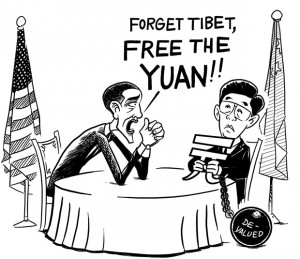The Rocky Road to Globalization
China’s 2.0 percent devaluation of the yuan on Tuesday pushed the U.S. dollar higher and hit equity markets worldwide as it raised the prospect of a new round of currency wars and fed worries about slowing Chinese economic growth.
Stocks fell in Asia, Europe and the Americas, as investors worried about the implications of a move designed to support China’s slowing economy and exports.
What is good for growth in China is unfortunately bad for everybody else. The Dow Jones industrial average .DJI fell 137.33 points, or 0.78 percent, to 17,477.84, the S&P 500 .SPX lost 11.74 points, or 0.56 percent, to 2,092.44 and the NasdaqComposite .IXIC dropped 20.10 points, or 0.39 percent, to 5,081.70.
The devaluation especially hit the stock prices companies exposed to China, with shares of U.S. heavy equipment maker Caterpillar (CAT.N) losing 2.3 percent and Germany’s Volkswagen (VOWG.DE) dropping 4.6 percent.
European shares fell. The pan-European FTSEurofirst 300 index .FTEU3 was down 1 percent, led lower by car makers and luxury goods companies, whose products have just got more expensive for Chinese consumers.
China’s move, which the central bank described as a “one-off depreciation” based on a new way of managing the exchange rate that better reflected market forces, triggered the yuan’s biggest fall since 1994, pushing it to its weakest against the U.S. dollar in almost three years.
In a potentially worrisome sign, China’s offshore yuan, a more liquid instrument traded out of Hong Kong, fell 2.9 percent, exceeding the fall in the onshore yuan. It suggests more possible losses for the onshore currency, as the Hong Kong-traded yuan tends to act as a precursor to the onshore.

